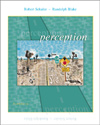 |  Perception, 4/e Robert Sekuler,
Brandeis University
Randolph Blake,
Vanderbilt University
Action and the Perception of Events
Chapter OverviewThis chapter emphasizes motion perception's many, varied contributions, from defining the three-dimensional shape of moving objects, providing information that we use in locomoting, to guiding the eye movements that we use as we explore the world. The chapter described the neural basis of movement perception and the circuitry used to extract motion signals. It explained how limitations of this circuitry produced a dependence on configural properties, including the shape of the aperture within which an object moves. We discussed two theoretically significant errors that motion perception commits, namely apparent motion and the motion aftereffect. After exploring parallels between the properties of natural events and the properties of neural mechanisms designed to register those events, the chapter ended with a discussion of important higher-order influences on motion, including attention. This chapter concludes our survey of visual qualities that enable you to appreciate various biologically important aspects of the world. Next we turn to other senses that also provide vital information about that world. We begin with the ear and hearing. |
|



 2002 McGraw-Hill Higher Education
2002 McGraw-Hill Higher Education